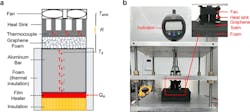Graphene-Infused Foam Provides Dynamically Tunable Path for Thermal Management
What you’ll learn:
- How graphene-infused foam has been evaluated as a tunable thermal resistor for passive adjustable cooling.
- The modeling that was done to investigate the concept.
- The two test fixtures used to measure and verify performance.
Keeping electronics cool or within a desired temperature band despite internal operating conditions and varying ambient environments continues to be a difficult design challenge. Passive techniques often are preferable but have limited range, while active techniques such as forced air driven by controlled fans adds cost, weight, and complexity.
To address this dilemma, a team based at Purdue University devised a patent-pending alternative approach relying on graphene-infused foam that compresses as needed, thus changing its thermal resistance and associated heat flow. Somewhat counterintuitively, this dynamic cooling “mechanism” is both passive and tunable.
Unlike a thermal on-off switch, the foam provides a continuous thermal-tuning range and therefore adapts smoothly to the thermal situation. (Note that graphene is yet another chemical allotrope of elemental carbon along with graphite, diamond, and others, yet it has unique properties and is enabling many very innovative developments; there’s some parallel to silicon in that respect.)
Their wide-range variable thermal resistor is based on highly compressible, open-pore graphene foam composites that function as a thermal switch or regulator, analogous to a variable electrical resistor (Fig. 1). This graphene foam is a commercially available product, built from nanoscopic particles of carbon deposited in a specific pattern, along with tiny entrapped voids of air.
Project leader and mechanical engineering professor Xiulin Ruan noted, “Most devices use passive thermal management such as conduction and convection to move excess heat. But those systems aren’t tunable or adjustable, and don’t help at all in cold conditions.”
When this foam is placed between a heat source and a heatsink, it modulates the flow of heat based on its amount of compression. When the foam is fully compressed, it has maximum thermal conductance (its “on” state). If the foam is fully uncompressed, it conducts heat poorly (“off” state)—with proportional conductance in between. The on/off thermal conductance has a large tuning range of nearly an order of magnitude.
Modeling and Testing
For the first step in the project, the team modeled the thermal performance of the graphene foam to assess its heat-transfer properties under different compression factors (Fig. 2).
However, this sort of theoretical analysis and associated modeling still needs real-world, lab-based testing for verification. As a result, they performed a range of quantitative tests with two different fixtures.
First, the Purdue researchers sandwiched a 1.2-mm-thick sample of graphene foam in-between a heater and heatsink (Fig. 3). They next placed the arrangement under an infrared microscope to measure the temperature and heat flow. When fully compressing the foam to a thickness of 0.2 mm, the thermal conductance went up by a factor of eight.
For the second set, the team used a chamber at Purdue’s Flex Lab that can create specific environmental conditions, and achieved similar results with ambient temperatures from 0°C (32°F) to 30°C (86°F). They placed the graphene foam on top of a heat source to simulate an electronic device and used thermocouples to measure the temperature (Fig. 4).
“This is important because the thermal switch adjusts to temperatures both inside and outside the device,” said Ruan. “When the ambient is very hot, our thermal switch can transfer heat out to cool the batteries down, and when the ambient is too cold, our thermal switch can turn off heat transfer to keep the batteries warm.” The team concluded that their variable thermal resistor can stabilize the operating temperature of a heat-generating device while the ambient temperature varies continuously by about 10°C or the heat generation rate varies by a factor of 2.7.
The work is detailed in their readable paper with the lengthy title “Wide range continuously tunable and fast thermal switching based on compressible graphene composite foams” published in Nature Communications, along with Supplementary Information. There are also short videos: “The compression process of graphene-PDMS foam in experiment” and “The compression process of graphene foam in molecular dynamics simulations.” In addition, there’s an untitled .gif clip that’s eerily visually reminiscent of the flesh-eating slime featured in many “sci-fi/horror-thriller genre” movies you’ve probably seen.
About the Author

Bill Schweber
Contributing Editor
Bill Schweber is an electronics engineer who has written three textbooks on electronic communications systems, as well as hundreds of technical articles, opinion columns, and product features. In past roles, he worked as a technical website manager for multiple topic-specific sites for EE Times, as well as both the Executive Editor and Analog Editor at EDN.
At Analog Devices Inc., Bill was in marketing communications (public relations). As a result, he has been on both sides of the technical PR function, presenting company products, stories, and messages to the media and also as the recipient of these.
Prior to the MarCom role at Analog, Bill was associate editor of their respected technical journal and worked in their product marketing and applications engineering groups. Before those roles, he was at Instron Corp., doing hands-on analog- and power-circuit design and systems integration for materials-testing machine controls.
Bill has an MSEE (Univ. of Mass) and BSEE (Columbia Univ.), is a Registered Professional Engineer, and holds an Advanced Class amateur radio license. He has also planned, written, and presented online courses on a variety of engineering topics, including MOSFET basics, ADC selection, and driving LEDs.




